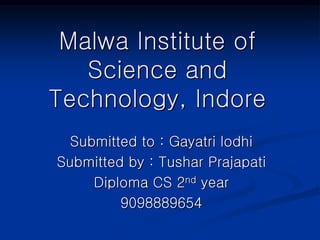
virtual memory.ppt
- 1. Malwa Institute of Science and Technology, Indore Submitted to : Gayatri lodhi Submitted by : Tushar Prajapati Diploma CS 2nd year 9098889654
- 3. Memory register CPU cache Main Memory Secondary Storage Server (or INTERNET) • larger capacity • lower speed • lower cost
- 4. What is… Virtual memory as an alternate set of memory addresses. Programs use these virtual addresses rather than real addresses to store instructions and data. When the program is actually executed, the virtual addresses are converted into real memory addresses.
- 5. History virtual memory was developed in approximately 1959 – 1962, at the University of Manchester for the Atlas Computer, completed in 1962. In 1961, Burroughs released the B5000, the first commercial computer with virtual memory.
- 6. Why is it needed…. Before the development of the virtual memory technique, programmers in the 1940s and 1950s had to manage directly two-level storage such as main memory or ram and secondary memory in the form of hard disks or earlier, magnetic drums. Enlarge the address space, the set of addresses a program can utilize. Virtual memory might contain twice as many addresses as main memory.
- 7. Object… When a computer is executing many programs at the same time, Virtual memory make the computer to share memory efficiently. Eliminate a restriction that a computer works in memory which is small and be limited. When many programs is running at the same time, by distributing each suitable memory area to each program, VM protect programs to interfere each other in each memory area.
- 8. How does it work… To facilitate copying virtual memory into real memory, the operating system divides virtual memory into pages, each of which contains a fixed number of addresses. Each page is stored on a disk until it is needed. When the page is needed, the operating system copies it from disk to main memory, translating the virtual addresses into real addresses.
- 9. MMU (Memory Management Unit) The hardware base that makes a virtual memory system possible. Allows software to reference physical memory by virtual addresses, quite often more than one. It accomplishes this through the use of page and page tables. Use a section of memory to translate virtual addresses into physical addresses via a series of table lookups. The software that handles the page fault is generally part of an operating system and the hardware that detects this situation.
- 10. Segmentation…… Segmentation involves the relocation of variable sized segments into the physical address space. Generally these segments are contiguous units, and are referred to in programs by their segment number and an offset to the requested data. Efficient segmentation relies on programs that are very thoughtfully written for their target system. Since segmentation relies on memory that is located in single large blocks, it is very possible that enough free space is available to load a new module, but can not be utilized. Segmentation may also suffer from internal fragmentation if segments are not variable-sized, where memory above the segment is not used by the program but is still “reserved” for it.
- 11. Paging…… Paging provides a somewhat easier interface for programs, in that its operation tends to be more automatic and thus transparent. Each unit of transfer, referred to as a page, is of a fixed size and swapped by the virtual memory manager outside of the program’s control. Instead of utilizing a segment/offset addressing approach, as seen in segmentation, paging uses a linear sequence of virtual addresses which are mapped to physical memory as necessary. Due to this addressing approach, a single program may refer to series of many non-contiguous segments. Although some internal fragmentation may still exist due to the fixed size of the pages, the approach virtually eliminates external fragmentation.
- 12. Paging……(cont’d) A technique used by virtual memory operating systems to help ensure that the data you need is available as quickly as possible. The operating system copies a certain number of pages from your storage device to main memory. When a program needs a page that is not in maim memory, the operating system copies the required page into memory and copies another page back to the disk.
- 13. Virtual Memory (Paging) Page table Address Space Page table Address Space Physical Memory
- 14. Page fault An interrupt to the software raised by the hardware when a program accesses a page that is not mapped in physical memory. when a program accesses a memory location in its memory and the page corresponding to that memory is not loaded when a program accesses a memory location in its memory and the program does not have privileges to access the page corresponding to that memory.
- 15. Paging replacement algorithms OPT(MIN) : eliminate the page that be not expected to be used. FIFO(first input/first output) : rather than choosing the victim page at random, the oldest page is the first to be removed. LRU(Least Recently used) : move out the page that is the least rarely used. LFU(Least Frequently used) : move out the page that is not used often in the past.
- 16. Summary… Virtual memory is a common part of most operating systems on computers. It has become so common because it provides a big benefit for users at a very low cost. benefits of executing a program that is only partially in memory. program is no longer constrained by the amount of physical memory. ⇒ user would be able to write programs for an extremely large virtual address space. more programs could be run at the same time ⇒ increase CPU utilization and throughput. less I/O would be needed to load or swap each user program ⇒ run faster
- 17. Thank you